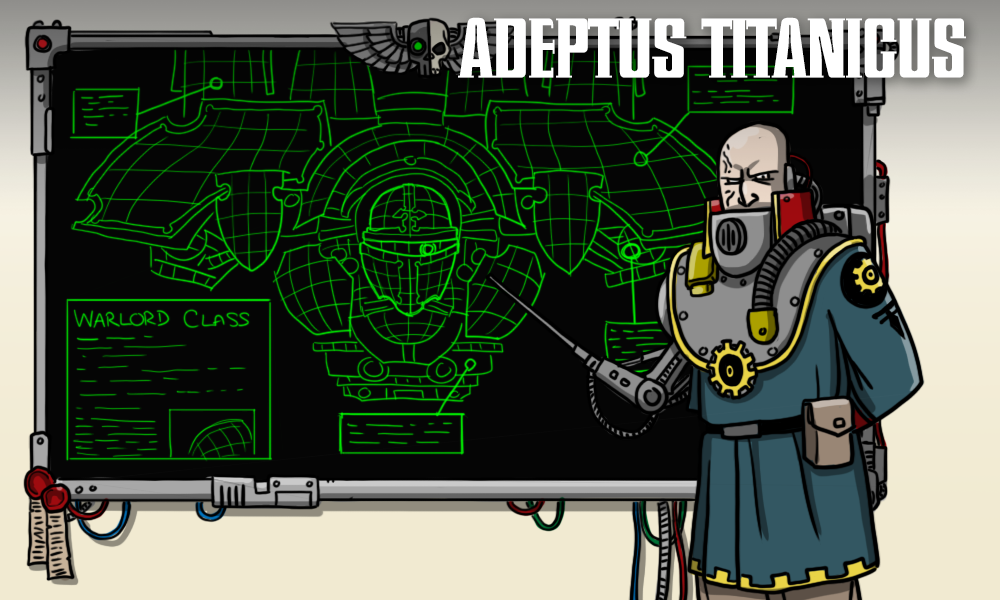Welcome back to Goonhammer’s series for aspiring Titan Principes. We here at Goonhammer’s own Collegia Titanica know that Adeptus Titanicus can seem intimidating to players unfamiliar with its particular quirks, but this series aims to equip you with everything you’ll need to play out epic clashes on the battlefields of the far future with your very own Titan Battlegroup. In this series, we’ll be walking you through how to build your battlegroup and command it to glory, including everything from which Titans to include and how to equip them, through to how to command them on the field of battle to secure ultimate victory.
Knights are a great way to supplement your God-Engines into battle, although you can go full David vs Goliath and take a force entirely made of Knights. If you’ve ever wanted to see how quickly a lance of Knights can dismantle a Warlord Titan, read on to learn how you can find out for yourself. If you want more or want start a Knight Household force, we would recommend picking up the Doom of Molech supplement where these rules were first introduced and the Defense of Ryza where these were expanded further.
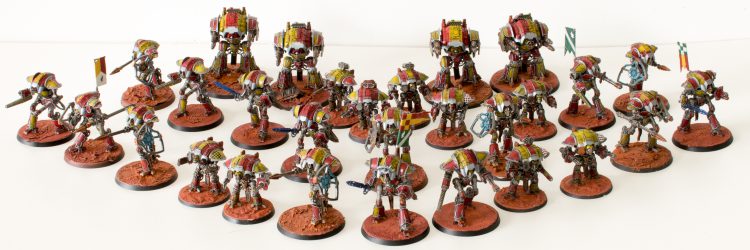
Table of Contents
What’s the difference between a Household Force and a Titan Battlegroup?
Where the Titan Battlegroups we’ve focused on in our previous articles can bring Knight Banners as support for their Titans, in a Household Force, the Knights are the main attraction. To stand against the God-Engines of the Collegia Titanica, they make use of some unique tricks to transform their Knights from useful support units into serious threats. However, as deadly as they can be when they combine their firepower, their fragility compared to Titans and diminishing effectiveness as they lose models means you’ll need to strike hard and fast if you want to have a chance of winning with them.
We want to be up front here: Knight Household lists are not for the faint of heart. That said, Coordinated Strikes make their already effective weapons into absolute terrors and transform some of their otherwise middling options into threats your opponent may not be prepared to anticipate. Plus, the sheer number of models you’ll be fielding will take some time for your opponent to chew through. However, they’re not as tough as even a Warhound Titan, and once they start taking losses, it can be difficult for them to rally. Don’t expect an easy win if you choose to field a Household Force, but if you’re up for the challenge, cleverly using your Knights to topple a Warlord is immensely rewarding.
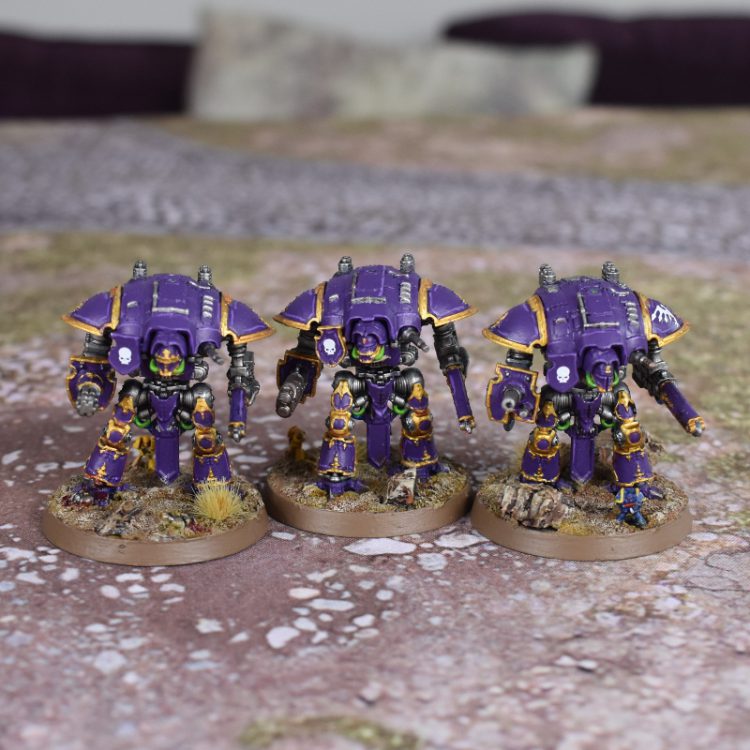
Strengths
- Coordinated Strike Orders: After the addition of Lances, the key mechanic introduced in a Knight Household force is the Coordinated Strike Order, which can only be given to a Banner within a Lance. This banner makes a single attack with one of the Banner’s ranged weapons, increasing the strength of the attack for each Knight assisting.
- Lance Orders: Very similar to squadron orders, you can issue an order across or to part of the lance using the leadership of its leader which works out better than doing them seperately.
- Flexibility: While the Knights in each of your Banners must each be equipped the same (unless they’re Freeblades), the number of Banners you’ll be bringing will let you equip your Knights to deal with any threat. In addition, the fact that every single model in your list has 360-degree forward arc and doesn’t have to worry about turning means that you can adapt to unforeseen game states better than your opponent can.
- Alpha Strike Potential: Since Lances all activate at the same time, you’ll be able to bring all of their weapons to bear to tear down one target before your opponent has the chance to react. Use this aggressively to take out targets before you lose too many Knights.
- Stratagems: Knight Households get access to their own unique stratagems and come with plenty of stratagem points to use them – your Seneschal adds 2 stratagem points to your pool, and each High Scion adds another 1. In other words, the more Lances you can cram into your list, the more stratagems you’ll be able to field.
Weaknesses
- Diminishing Returns: Just like Support Banners in Titan Battlegroups, your Knights’ defensive effectiveness is determined by how many of them are still standing. However, in Household Forces, their offensive output also suffers as Knights are destroyed, making their Coordinated Strikes less effective. Each Knight you lose is an effective -1 strength to its Banner’s attacks against high-armor targets, and unlike in Titan lists, you won’t have volcano cannons backing them up.
- Loadouts are Rigid: With the exception of your Seneschal’s Banner, each Knight in the same Banner must be equipped identically. Additionally, due to the way the Coordinated Strike Order works, you’ll probably want to avoid taking the same weapon twice on Questoris – you roll a number of dice equal to the weapon’s Dice characteristic, and add strength based on the number of Knights who participate, so a banner full of dual avenger gatling cannon Knights will still only get 8 shots when making a Coordinated Strike.
- Activation Count: Even though individual Banners are fairly inexpensive, the cost of your Lances will rack up quickly. The cheapest Questoris Lance, 3 Banners of 3 Questoris Gallants each, clocks in at 350 points – more expensive than a blinged out Reaver and less useful. To get real use out of your Lances, they’re going to be expensive, and you may find yourself struggling to outmaneuver high activation-count Titan lists despite your superior mobility on paper. You can pad this out with Freeblades, but doing so could reduce the number of stratagem points you’re able to use.
- Coherency Requirements: You’ve got to maintain coherency, which limits your Banners’ ability to move across the board – and not only do the Knights in a Banner have to maintain coherency, the Banners in a Lance must as well. Keep this in mind when moving your models so you don’t lose coherency at the wrong time.
- Morale: Knights retain their vulnerability to losing their comrades, but now that you don’t have any Titans in the list, any model in your list could become Shaken if things go wrong. Take special care to protect your Scions and Seneschal, as your enemy can use Targeted Attacks to choose the model they destroy when they shoot at you, potentially lowering your Knights’ Command values and making them more vulnerable to morale and less likely to take orders.
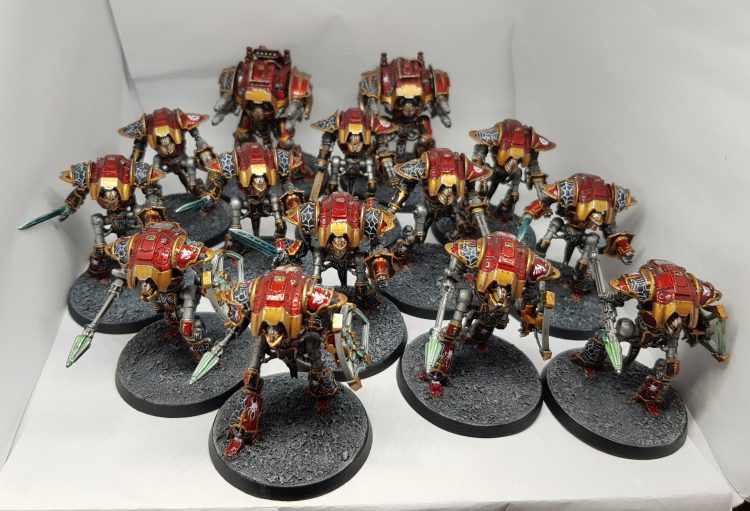
Mustering the Household
Lances
Your Knight Household Force is composed of at least one Lance, and can take additional Lances or support units to fill out the points. Each Lance consists of three Banners, two of which must be the same chassis, and the Knights in each Banner must be equipped identically excluding upgrades such as Missle Pods or Meltaguns. One of the Scions within a Banner is nominated to be the High Scion, who leads the Lance into battle and gives you one Stratagem point before the game begins. The High Scion’s Banner martial prowess gives their Banner the ability to reroll hit rolls of 1 when using their weapon skill – make sure they have a melee weapon to make the most of this.
Seneschals/High Kings
One of your lances will be lead by a Seneschal rather than a High Scion, who is in overall command of your force. Being more skilled than the High Scion, they have similar abilities but better including granting an additional Stratagem point and getting to reroll hit rolls of one when using Ballistic Skill. One key difference from all other Banners within a Lance is that they get to have different loadouts of equipment within their Lance due to the Baronial Court rule, which means you can have an Lancer bodyguard for your Acheron Seneschal.
If that wasn’t enough, you can upgrade your Senechal to the High King of the household for 50 points. This upgrade is very worthwhile for an additional Strategem point and improved consistency – your High King’s banner becomes completely immune to being Shaken and automatically passes command checks during the strategy phase even if another unit has failed an order.
Soggy: I’d go so far as to say this is nearly a compulsory upgrade as there is nothing worse than failing a Charge or Coordinated strike order and the extra Stratagem point is a nice bonus.
Your Seneschal or High King also gets a personal trait – much like a maniple’s Princeps Seniores. There is a common pool of traits to pick from, as well as a selection specific to your Household (assuming they’re lucky enough to have rules). Many of these traits have powerful effects which have a massive impact on how their lance will operate, such as the ability to automatically pass command checks for specific orders like Charge or Combined Fire or making nearby Banners immune to being Shaken. Similar to the Princeps Seniores, this trait is only valid while they remain on the table, making it important to keep them alive to make the most of these powerful abilities.
Soggy: A FAQ ruling may change how this works, but as written, only Seneschals and High Kings get Knightly Qualities. That said, each specific Knight houses table of Knightly Qualities does make mention of High Scions, which doesn’t make sense. I’d like to see this clarified by GW, so make sure with your opponent or TO in advance to their thoughts on this one, as it feels like the intent is that each Lance gets them as per a Maniple’s Princeps Seniores.

Alignments
Defense of Ryza formalised the declaration of alignment of your forces, giving your household more flavour with some cool rules to boot. Each of the four alignments have a set of Knightly Qualities and a unique Allegiance ability, some of which are incredibly powerful.
Questoris Imperialis households are the sworn to the Emperor and get the amazing Valorous Charge ability – letting them once per game add 2″ to the movement an entire lance during the movement phase, setting up for some insane charges with 16″ threat range on Cerastus Knights. One of their Knightly Qualities, Master of War, lets increases this further 2″ to all banners within the lance.
Questoris Mechanicus households hold their oaths to the Omnissiah and the Cult Mechanicus. Due to the Schism of Mars, this means this is a valid choice for both Loyalist and Traitor forces. Their superior technical might grants them the Targeting Solutions ability, which once per game allows all banners within a lance be able to take Coordinated Strike, Split Fire or First Fire orders without a command check – allowing for a turn of guaranteed withering fire. This pairs nicely with a Seneschal Trait such as Second Son, which will allow your Banners to reroll hit rolls of one for BS attacks.
Questoris Traitoris households have declared for the Warmaster, repudiating their former oaths. Their Lust for Blood Allegiance ability allows you to once per game add 1 dice to a single weapon type with the Melee trait to all knights within a banner during the combat phase. Best of use of this will be on a High Scion or Senechal’s banner with their innate rerolls of 1 on as big a lance as possible. If you somehow managed to get 6 Questoris Knights with double melee weapons all into position you could do 24 attacks! Somewhat more realistically, a banner of 3 Lancers making a 9″ charge would drop a staggering eighteen shock lance attacks into the target of their choice, all but guaranteeing a kill. Nasty.
Questoris Oblitus households found themselves caught in the crossfire between the Loyalists and Traitors, fighting for their survival. This grim determination in the face of adversity is reflected by the Firm Resolve allegiance ability – which allows them to choose to automatically pass a single shaken test per turn, giving some much needed consistency. Struggling to survive gives them some really unique Knightly Qualities, our favourite being Xenos Sympathiser – which gives their banner the ability to reroll all failed ion shield saves, and means they’ll always have at least a 6+. While definitely the greedy option, having a banner that can shrug off a volcano cannon on a lucky roll is nothing to sneeze at.
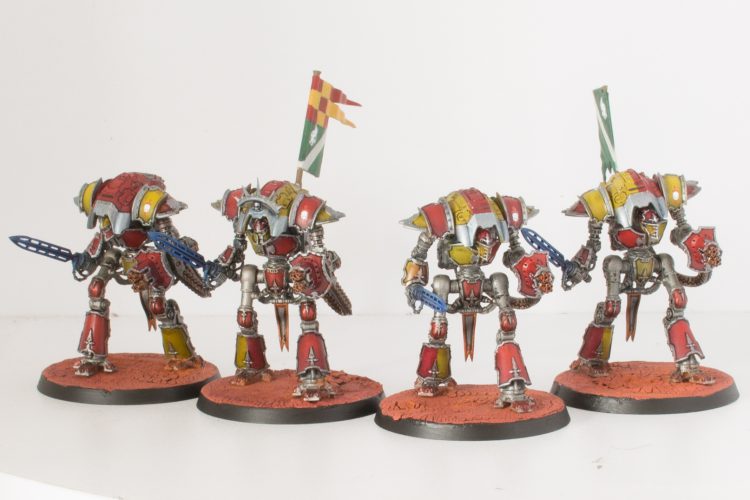
Banners
Each Lance can march to war under a standard carried by the High Scion or Seneschal/High King’s Banner. These standards have potent effects which will impact how the lance operates to give you an edge on the battlefield. There are two main types of standard – Battle Standards which can only be taken within the Seneschal/High King’s Banner and Lance Standards which are taken by a High Scion’s Banner. We’re not going to list these all out but it’s pretty important to try and fit these in due to how much impact they can have.
Some of our favourites include:
Stalwart Standard: A Battle Standard which downgrades the first crit a banner within 12″ of the standard takes each round to a devastating hit for 50 points – this will save you instantly removing a model each time you take a crit, which as a Knight player will happen several times each game.
Standard of Defiance: A Lance Standard which for 10 points lets all banners within a Lance remove the shaken status and allows them to be issued orders. There’s nothing worse than being hit by a quake cannon and losing your ability to charge – 10 points is a steal for this sort of get-out-of-jail card.
Icon of Conquest – A Lance Standard that can only be taken by Questoris Oblitus Households, which gives all friendly banners within 6″ of the standard +1 strength to their weapons once per game for 35 points. This has several uses, although one of the more fun interactions for this is to unleash a turn one volley with your Avenger Gatling cannons against voids without a coordinated strike order as you won’t need it to get strength 4.
The Household Armory
When equipping your Household Force, you can largely follow the guidelines from our Knight Focus article. However, a few options available to support Banners are worth taking another look at in a Household Force list:
- Avenger Gatling Cannon: In a banner supporting Titans, this weapon doesn’t work that well – at strength 3, it can’t damage void shields and only really has a chance of breaching armor if you’re attacking a wounded Titan from the flank or rear, and you’ve usually got better options for finishing off your targets. In a Household Lance, though, it’s got a whole new lease on life. The Coordinated Strikes order lets it attack at a minimum of effective strength 5, bringing its 8 dice up to the same strength as a gatling cannon, spiking as high as strength 9 if you’re firing with a full banner. This gives you a reliable weapon that will put out a decent number of direct hits on nearly any target. And if you do find yourself in the rear arc of a wounded Titan, firing these individually for the absurd number of shots could be useful. If you’re dead-set on fielding a few Knights equipped with this weapon, a Household Force is the way to do it. You’re going to need to keep every single Knight in the Banner alive to get mileage out of it, though. It still won’t be able to hurt void shields (the bonus is to Armour rolls, not the weapon’s strength), but with 8 shots into armor with Rapid you’re going to put a few points of damage into nearly anything.
- The same advice goes for the Cerastus Knight Castigator, though the lower shot count limits the effectiveness, and the inability to double up on them means you won’t be able to really let loose if you can set up that perfect storm of bonuses to the armor roll. On the other hand, the warblade’s 2 dice and Rending trait makes it more effective than the Questoris’s melee weapon, especially if you can get there with 3 or more still alive in the Banner. All in all, we’d avoid overinvesting in AGC-equipped Questoris or Castigators since they’re more situational than your other weapon options. Generally speaking, you’re better off using your rules to make your good options even better than making a mediocre weapon good.
- Rapid-Fire Battlecannon: This was a solid choice before, but now it’s legitimately scary. Your Banner can either drown your opponent in gatling blaster-equivalent fire, or focus fire with the Coordinated Strikes order to outshoot a Warlord’s macro-gatling blaster, potentially spiking to strength 11 if you can manage to keep a full Banner on the table long enough. Throw in a handful of rocket pods and you’ve got the makings of something scary, if you can keep them alive long enough to fire.
- Thermal Cannons: Strength 8 with the Fusion trait means a volley of these things will shred armor in close, and you can make a Combined Strike to all but guarantee a devastating hit into almost any target. Packs a hell of a punch, but really needs to get in close to make use of it – just remember that you can’t make Coordinated Strikes within 2″ of a target. Not that you care, as 4-5 of these rolling d10s into a Titan’s rear arc will make short work of just about anything.
Support
In addition to Lances, Household forces can take a number of support units to complement them on the field. Standalone Freeblade Knight Banners can be added, which are a cheap source of additional activations to ensure you don’t get completely outmaneuvered by a Titan Battlegroup. Due to being lone warriors, they can be equipped as you please but can’t be issued Coordinated Strike orders. As of the 2020 FAQ, Acastus Knights Banners can only be fielded as a support banner and you are limited to a single Banner per Lance. Even with this restriction and the points hike, Acastus Knights are a force to be reckoned with and you’ll almost certainly want to take at least one as they provide a source of devastating firepower and some backfield resiliency.
Otherwise, you can take Support Titans akin to Titan Battlegroups to complement your force. A Titan’s Volcano or Melta Cannons can make quick work of enemy armour, allowing your weaker Knights’ armaments to find their mark. Just remember that if the Titan is using Legio Rules you will be giving your opponent 2 SP for the privilege, a cost unlikely to be worth it.
Bringing it all together
When you’re building your Lances, you’ll want to try as much as possible to ensure that the Knights in those Lances have similar roles on the battlefield to take advantage of Lance Orders. Like Titan squadrons, Lances can issue the same order to any number of their constituent Banners with a single Command check, letting you use your High Scion’s improved Command value to all but guarantee that they’ll resolve the order. This is even more important in your Seneschal’s Banner, since many of the personal traits available to them allow them to issue various orders without even having to roll, which can be very handy in the clutch. Plus, since your Lances need to keep coherency, mixing fire support and close combat Banners will mean you won’t be able to get the most out of them.
You’ll generally find that melee focused Lances will use a mix of Cerastus and Questoris Banners to keep costs down. Ranged Lances will tend use a mix of Questoris and Questoris Mechanicum Banners with Acastus freeblades as fire support . Keep in mind that Titan Battlegroups will typically have a minimum of 3 activations, and that that number only goes up as the points limit increases. Which means you need to decide on how many activations you want as while you may not need to worry about your own arcs of fire, giving away the activation advantage entirely might result in you being unable to get favorable shots into flank or rear armor, potentially denying you a kill.
Taking this in mind, we would probably look at trying to squeeze in two lances with a freeblade at 1500 points to give you at least three activations. One melee focused lance and one ranged to hold the backfield and any objectives.
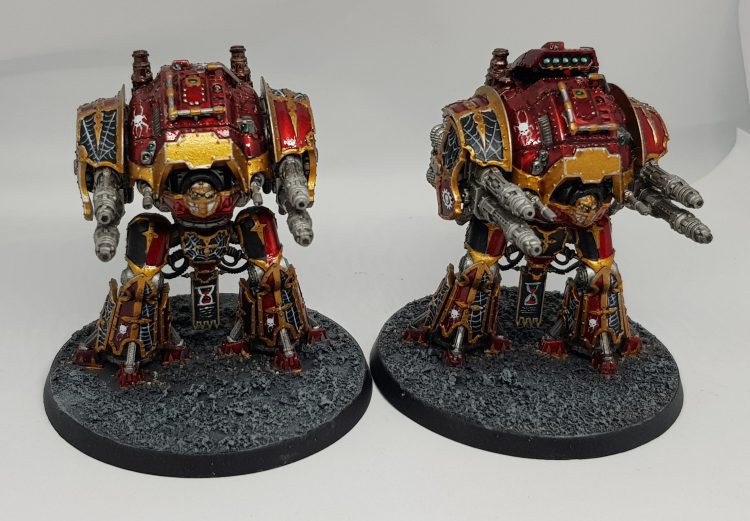
Commanding Your Household
In General
Knights play very differently from Titans, and those differences are only magnified in a Household Force. Titans are much more durable and don’t suffer from diminishing returns in the same way that Knights do. Even the relatively fragile Warhound Titan requires significant focus to take off the table, and any critical hits or damage to weapons that might decrease its combat effectiveness aren’t permanent, since its servitor clades can repair that damage if given enough time. By contrast, even a Banner of Acastus, the most durable Knight in the game, can suddenly vanish from the battlefield with decent luck from a belicosa.
With that in mind, in order to get use out of your Knights, you’ll need to ensure that they’re able to stay alive long enough to bring their weaponry to bear. Play carefully around terrain and try to approach from off-angles. Use Freeblades to inflate your activation count so that you can keep your Lances outside line of sight or firing arc of weapons like quake cannons or volcano cannons that pose major threats. You’ll generally want to move your Freeblades first since it’s easier to keep them hidden, then move your Lance once the enemy has committed their units so that it’s harder to focus their fire. As with Support Banners in Titan lists, you’ll want to take advantage of your superior speed and maneuverability to rapidly strike from cover and move into your target’s flank or rear arc, both to avoid incoming fire and to get the most mileage out of your weaponry.
In the Combat phase, you’ll want to take advantage of your Lance’s ability to concentrate large amounts of firepower into a single activation in order to focus down targets and force as much of your firepower as possible toward the top of the round and into a single target. Use your Freeblades like you would support Banners in a Titan Battlegroup, clogging up the battlefield and making room for your Household’s Lances to go to work, or standing back with Acastus sending as much hate down your chosen firing lane as you can. As usual, coordinate your fire on a single target to make your first strike count – a Banner that’s down a Knight or two will quickly find that it’s losing effectiveness, while a Titan will still hit back just as hard until you’ve put a few points of critical damage on it.

Striding to War
Knight Household Forces offer a different way to play Adeptus Titanicus for players who are willing to take on the unique challenges they pose. Their organization into Lances lets them dish out amazing amounts of damage and gives them access to more choice in stratagems, but the more structured organization of their forces compared to Support Banners imposes limits on their ability to outmaneuver Titans, and mounting losses will quickly put the brakes on their ability to deal out the pain. However, if you build your list wisely and play to your strengths, you’ll be able to take the fight to the Titan legions and might just come out on top.
